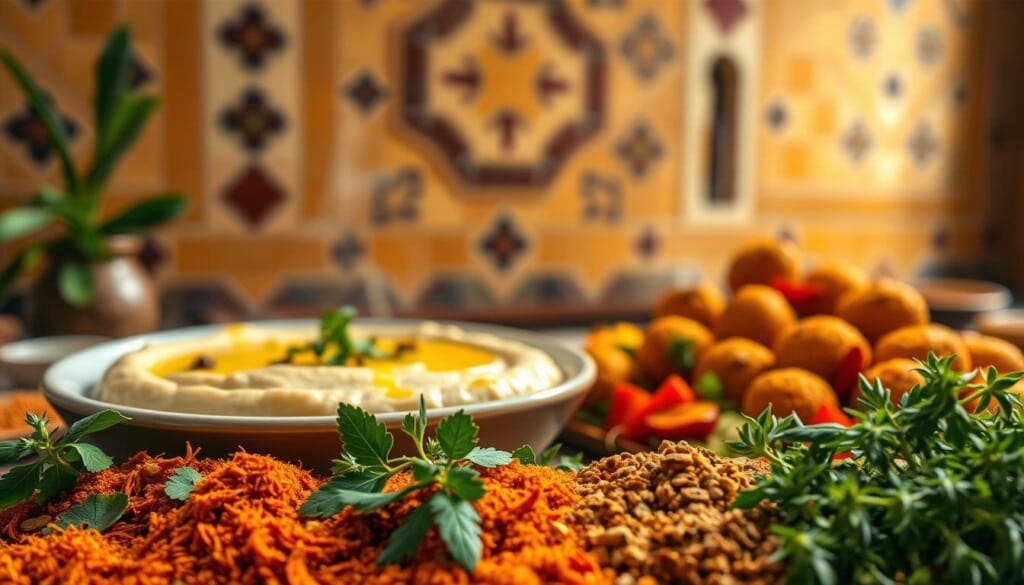Ever wondered why Middle Eastern food is so popular in the US? It’s not just the spices or flavors. It’s the whole experience. Middle Eastern food restaurants are popping up everywhere, showing how much people love authentic dishes.
Trying Arabic food has become a fun journey for many. This article will take you on a tour of the best places to try Middle Eastern food in the US. Get ready to explore a world of flavors.
Key Takeaways
- Middle Eastern cuisine encompasses a variety of flavors and ingredients.
- Discover the rise of Middle Eastern food restaurants across the US.
- Authentic Middle Eastern dishes are gaining popularity among diverse diners.
- Delectable Arabic food offers a unique culinary experience.
- The dining experience is enriched by cultural traditions of sharing meals.
The Rich Tapestry of Middle Eastern Cuisine
Middle Eastern cuisine is a mix of flavors, textures, and traditions. It’s known for its wide range of tastes. This cuisine comes from many influences and uses traditional ingredients.
The result is a blend of vibrant tastes that excite the palate. It also attracts those looking for new dining experiences.
Overview of Middle Eastern Food
Middle Eastern food combines aromas and tastes from countries like Lebanon, Turkey, Iran, and Israel. It’s known for using fresh, local ingredients and spices. This makes each dish unique.
This cuisine offers both well-known dishes and hidden gems. Both are worth trying.
Key Ingredients in Middle Eastern Cooking
Chickpeas, lentils, rice, and spices like cumin and coriander are key. Olive oil adds richness to dishes. Herbs like parsley and mint add freshness.
Tahini, a sesame paste, is essential for creamy sauces and dips. It’s a must-have in Middle Eastern cooking.
Popular Dishes to Try
Hummus, shawarma, and kebabs are favorites. Hummus, a chickpea dip, is great with pita bread. Shawarma, with its seasoned meat, is a treat.
Kebabs, grilled meat skewers, mix spices and cooking perfectly. Each dish is a taste of shared culinary heritage in the Mediterranean.
Why Middle Eastern Food Resonates with Americans
Middle Eastern cuisine is becoming more popular in the United States. Its rich flavors, cultural practices, and health benefits are key reasons. The mix of spices like cumin, coriander, and sumac makes meals exciting for everyone.
The Flavor Profiles and Spices
Middle Eastern food is known for its unique spices. These spices add depth and variety to dishes. They range from warm and earthy to fresh and zesty, appealing to many.
Cultural Significance of Food Sharing
Sharing meals is a big part of Middle Eastern culture. It brings families and friends together. This tradition is attractive to Americans who love to share meals and bond over food.
Health Benefits of Middle Eastern Cuisine
Middle Eastern food is also known for its health benefits. It includes fresh veggies, whole grains, and healthy fats. These ingredients promote well-being and are becoming more popular as people seek healthy options.

How to Find the Best Middle Eastern Restaurants
Finding the best Middle Eastern restaurants is easier with the right tools. Use review sites and apps to explore different places. These tools let you see ratings, reviews, and pictures, helping you choose where to eat.
Top Review Sites and Apps
Many sites help you find great places to eat. Yelp and TripAdvisor are top choices. They let you search for “best Middle Eastern restaurants” near you.
LocalZ: A Game Changer for Finding Food
LocalZ is a big help in finding local food. It makes searching easy with community reviews and ratings. You can also pick your favorite dishes, making your choice more personal.
Engaging with the Community for Recommendations
Talking to food lovers on social media is also helpful. Joining local groups can lead to great finds. People share their favorite spots, helping you discover new places. For a more organized search, check out LocalZ for lists of authentic Middle Eastern food.
Featured Middle Eastern Restaurants Across the US
The United States is home to many notable Middle Eastern restaurants. These places showcase the vibrant tastes and traditions of the Middle East. From the West Coast to the East Coast, and through the Midwest, diners can find diverse flavors that capture the essence of Middle Eastern cuisine.

West Coast: California’s Culinary Gems
California is known for its West Coast Middle Eastern gems. Restaurants like Zankou Chicken and Marouch offer authentic dishes. They serve everything from shawarma to falafel, highlighting California’s focus on fresh ingredients and creativity.
East Coast: New York’s Authentic Spots
New York’s East Coast dining is unmatched. Places like Cafe Mogador and Shukette are famous for their lively atmospheres and rich menus. They feature beloved dishes like tagines and mezze platters, making them a must-visit for Middle Eastern cuisine lovers.
Midwest: Hidden Treasures in Chicago
The Midwest, and Chicago in particular, has its own hidden treasures. Restaurants like Alhambra Palace and Abu’s Homestyle Kitchen offer flavorful dishes that celebrate their culinary roots. These spots are perfect for exploring the heart of Middle Eastern cooking in the Midwest.
South: Flavorful Finds in Texas
Texas in the South is a vibrant place for Middle Eastern flavors. Restaurants such as Aladdin Mediterranean Restaurant in Houston offer innovative twists on classics. This culinary scene provides a variety of tasty options for those eager to try traditional dishes with a southern twist.
Dining Experience: What to Expect
The Middle Eastern dining experience is a mix of flavors, aromas, and hospitality. When you enter a restaurant, the warm atmosphere grabs your attention. It’s filled with decor that shows off the rich cultural heritage.
Seating areas are set up to make you feel at home. They invite you to relax and enjoy the food. This setting brings traditional dining customs to life.
Ambiance and Decor of Middle Eastern Restaurants
Middle Eastern restaurants are known for their vibrant colors and traditional artwork. The decor is detailed, making every meal special. Low seating and shared tables highlight the importance of togetherness.
Guests often remember the food and the atmosphere. It’s not just about the food; it’s about the whole experience.
Traditional Dining Etiquette
In Middle Eastern cultures, sharing meals is key. Guests try different dishes, served family-style. This makes the meal more engaging and social.
Using bread to scoop up dips is part of the etiquette. It shows the communal nature of the meal.
Catering Options and Dietary Accommodations
Many Middle Eastern restaurants offer food for all diets. You can find vegetarian, vegan, and gluten-free options. This makes sure everyone can enjoy the food.
Catering services also make Middle Eastern dishes available for events. This makes the cuisine more accessible to more people.
Signature Dishes You Must Try
Exploring Middle Eastern cuisine reveals a world of must-try dishes. Each dish showcases unique ingredients and traditions. These selections highlight the signature Middle Eastern flavors that have won hearts worldwide. You’ll find a variety of popular appetizers and desserts that make the meal complete.

Hummus: The Classic Dip
Hummus is a staple in Middle Eastern cuisine. It’s a smooth mix of chickpeas, tahini, lemon juice, and garlic. Enjoy it with pita bread or fresh veggies. Its creamy texture and rich flavors make it a favorite everywhere.
Shawarma: A Street Food Favorite
Shawarma is a beloved street food in the Middle East. It features marinated meat cooked on a vertical rotisserie. Served in pita or flatbread with fresh veggies and sauces, it’s a must-try.
Kebabs: Grilled to Perfection
Kebabs showcase Middle Eastern grilling techniques. These juicy skewers of marinated meat, like lamb, chicken, or beef, are served with rice or salad. The charred outside and tender inside are a taste of Middle Eastern flavors.
Baklava: A Sweet Ending
No meal is complete without baklava, a famous Middle Eastern dessert. It’s layers of flaky pastry, nuts, and honey syrup. Baklava offers a delightful mix of textures and flavors, ending any meal on a sweet note.
If you’re eager to explore Middle Eastern food, join a community that shares your passion. Register at LocalZ for insights and experiences.
Joining the Middle Eastern Food Community
Getting involved in the Middle Eastern food community is exciting. It lets you dive into the rich flavors and traditions. You can join food festivals, take culinary classes, and connect through online groups.
Food Festivals and Events to Attend
Food festivals celebrate Middle Eastern traditions. They offer a chance to try different dishes and learn about ingredients. You can taste authentic foods, watch cooking demos, and talk about the culture behind the cuisine.
These events bring people together. They help food lovers understand the depth of Middle Eastern cooking.
Cooking Classes and Workshops
Culinary classes are great for learning to make traditional dishes. Expert chefs teach you how to blend spices and make pastries. It’s a hands-on way to improve your cooking skills.
These workshops also connect you with others who love Middle Eastern food. You learn together and share experiences.
Community Blogs and Social Media Groups
Online spaces like blogs and social media groups are key for Middle Eastern food fans. They’re places to talk about recipes, share tips, and find out about food festivals. You can also share your own stories and discoveries.
These platforms help you feel part of a community. They make you feel connected and engaged.
Supporting Local Businesses with LocalZ
LocalZ is a key player in boosting local Middle Eastern restaurants’ visibility. It focuses on key areas to help local businesses thrive. With its easy-to-use interface, LocalZ connects people with great food nearby. It also encourages supporting local businesses.
How LocalZ Helps Restaurants Gain Visibility
LocalZ shines by making restaurants more visible in the community. It offers a platform for local eateries, helping people find new places to eat. Users can search by cuisine, location, and ratings, making it easy to find what they’re looking for.
Unique Features of the LocalZ Platform
LocalZ stands out with features that make it fun for everyone. Customers can leave reviews, helping restaurants build their reputation. The platform also has advanced filters, making it easy to find the perfect spot to eat.
Giving Back to the Community: LocalZ’s Mission
LocalZ does more than just connect people with food. It gives back to the community by supporting local organizations. This helps local businesses grow and brings people together, making the community stronger.
Conclusion: Savor the Experience
The United States’ food scene is changing, and Middle Eastern cuisine is at the heart of it. These dishes bring rich flavors and traditions that excite our taste buds. They also help us appreciate the cultures that shape America’s food identity.
By choosing Middle Eastern food, we celebrate a wide range of ingredients and cooking methods. These have been perfected over centuries. It’s a way to honor the culinary heritage of the Middle East.
The future of Middle Eastern food in America is bright. More people want real flavors and unique dining experiences. Restaurants are mixing old traditions with new ideas, attracting more customers.
This mix of old and new makes Middle Eastern cuisine a key part of American dining. It shows no signs of slowing down, promising a rich and diverse food scene.
To enjoy real Middle Eastern food and find local spots, check out LocalZ. This platform makes it easy to find great places to eat. Your next meal could be a journey into a world of flavors and community.

